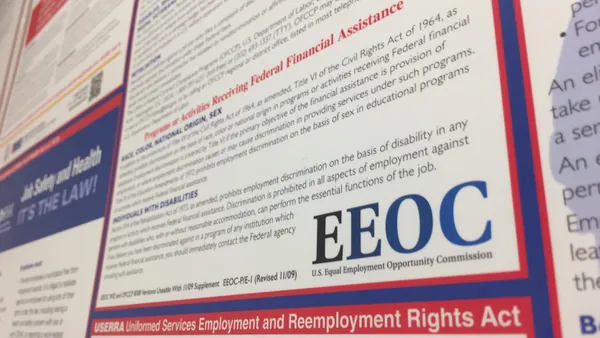In “Other Duties as Assigned,” HR Dive Lead Editor Kate Tornone weighs in on employment trends, compliance best practices and, of course, the situations that require you to go above and beyond your normal duties. Today: making sense of reassignment.
The Americans with Disabilities Act favors accommodations that keep employees at work in their current roles, but also says employers may be required to reassign workers to vacant positions for which they’re qualified.
That’s generally considered the accommodation of last resort, and case law on the issue remains unsettled. Circuit courts are split on whether the law entitles workers with disabilities to noncompetitive transfers, for example, and the U.S. Supreme Court has yet to weigh in. But that’s not the only question plaguing HR pros when it comes to reassignment.
Those in the industry often ask during conference Q&A sessions whether there’s a limit on how long — and far — they must search for those vacancies.
Unfortunately, there’s no clear-cut answer. Citizens Bank and the U.S. Equal Employment Opportunity Commission recently settled an ADA claim; among other things, the employer agreed to implement a noncompetitive reassignment policy that requires its talent acquisition professionals to look for vacancies for 90 days and within a 50-mile radius from the employee’s worksite.
I wondered whether those numbers could be instructive for other employers aiming to comply with the ADA and stay off EEOC’s radar, but David K. Fram, director of ADA and EEOC services at the National Employment Law Institute, said he doesn’t see it that way.
In terms of time, Fram said three months seems long; he tells employers it’s a snapshot. In other words, consider what jobs are open now, and what will be available soon. “You’re not required to keep looking and looking and looking,” he said.
EEOC’s guidance on the topic is similar: “‘Vacant,’” it says, means “the position is available when the employee asks for reasonable accommodation, or that the employer knows that it will become available within a reasonable amount of time.”
But when it comes to mileage, Fram advises employers to think bigger, saying he certainly would not recommend that an employer limit its search to 50 miles. In fact, he doesn’t recommend a distance limit at all: “I teach employers as a best practice that they should look anywhere they are — starting with the locations closest to home, of course, and then moving out. And if you can’t go far and wide, you’d have to argue undue hardship.”
And if you’re wondering about Fram’s take on the competitive vs. noncompetitive question, he said the safest position — “and certainly the position EEOC would follow” — is to give noncompetitive transfers.













